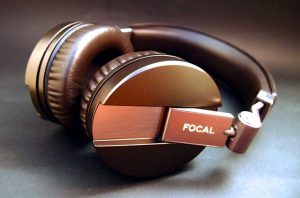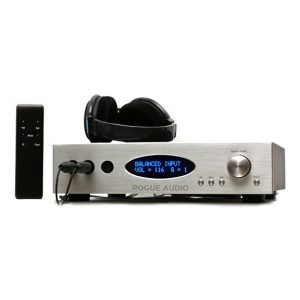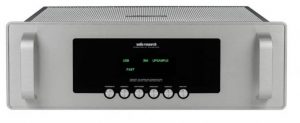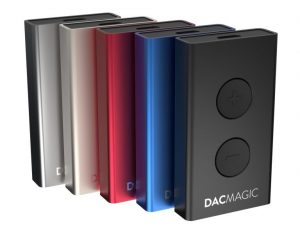18 Jul The Head Space

There has definitely been a shift in the overall focus of personal audio across the HiFi landscape, and understanding the tendencies and features of headphones, headphone amps, and desktop DAC’s will enable you to pick what suits your needs specifically. The benefits of a lot of these technologies can seem somewhat situational, so I’m hoping to help suss out which type of product is right for which type of environment.
Open Back Headphones
 – Headphones that have a non-sealed canister which holds the speaker’s driver.
– Headphones that have a non-sealed canister which holds the speaker’s driver.
The drivers in a headphone cup are generally like any other speaker drivers; They move back and fourth in a bellowing excursion. The sound moves in two directions, toward the ear & away from the ear. Open back headphones allow this sound to escape from the back of the driver, creating a more natural soundstage. These designs produce sound more akin to listening to a live concert. When listening, you can hear the music, as well as the ambient noise of your surroundings. For these reasons, open back headphones are typically more desirable for reference level critical listening. The drawback of open back headphones is that the listener will still hear the space around them, and anyone else nearby will also be able to hear the sound from them. (not ideal for traveling…)
Closed Back Headphones
 – Headphones that have a sealed cup to isolate the drivers.
– Headphones that have a sealed cup to isolate the drivers.
The drivers in closed back headphones are sealed to provide more isolation for the driver and listener. This style of headphone is vastly more common than open back. Headphones with enclosed cups will see a measurable increase in bass slam, but at the cost of frequency definition. Much like having a rear-ported speaker too close to the wall behind it, the closed back design exaggerates the bass response to be more present, but occasionally flabby and lacking accuracy. The largest advantage closed back designs have over their open back counterparts is the fact that the listener is isolated and can enjoy music privately.
Headphone Amps
 – Amplifiers specifically made to power headphones.
– Amplifiers specifically made to power headphones.
The impedance of headphones (measured in ohms) can fluctuate. This is due to the level of sophistication found in the driver’s voice coil. Low impedance headphones are the most common, and make up the majority of in-ear, on-ear, and over the ear designs. These low impedance headsets work perfectly well with gaming systems and mobile devices such as; cell phones, MP3 players, and tablets. High impedance models tend to sound clearer and more transparent, with better bass definition, and a perceivably larger soundstage. These higher impedance headphones require more voltage to operate at full potential. A dedicated headphone amp delivers the necessary power to higher impedance units and, more often than not, at multiple resistances. While home speakers have an impedance of 2 – 16 ohms, headphones can sit anywhere between 8 and 600 ohms. This is why a quality headphone amp is the only way to guarantee that your headphones sound as good as they could.
Desktop & Mobile DACs
 – Digital to Analogue converters – for use with computers and mobile devices.
– Digital to Analogue converters – for use with computers and mobile devices.
A lot of people store the majority of their music collection on a computer. The computer neatly stores and organizes your albums and makes it convenient to access and play them. The problem is that most personal computers utilize an integrated soundcard found on the motherboard. These integrated soundcards make it possible for the system to produce sound, but only at the bare minimum specs. A dedicated external DAC will generally play at a much higher bit depth, sometimes as high as 32 bit. The benefit of an external DAC is that it will decode your digital music at the highest possible bit depth, and not force it to play at a lower than available resolution. Some DAC’s have a full compliment of digital inputs and analogue outputs, capable of receiving various digital sources and sending them as “line level” signal to a preamp. These larger DAC’s with more i/o routing options are a fantastic way to add your computer to your music system.
 Other DACs will only have a single input and output. These are more specifically geared toward personal devices like laptops, smart phones, and portable music players. The majority of both large and portable DACs have a dedicated headphone output. This headphone output is occasionally the only analogue out found on a device. A DAC might not include such a comprehensive feature set for headphone listening, ie; variable impedance, multiple headphone output types, etc… but will offer better playback than your computer’s/mobile device’s headphone jack.
Other DACs will only have a single input and output. These are more specifically geared toward personal devices like laptops, smart phones, and portable music players. The majority of both large and portable DACs have a dedicated headphone output. This headphone output is occasionally the only analogue out found on a device. A DAC might not include such a comprehensive feature set for headphone listening, ie; variable impedance, multiple headphone output types, etc… but will offer better playback than your computer’s/mobile device’s headphone jack.
Hopefully This blog answers some questions, but probably creates some new ones…. If you want to keep the dialog going, please feel free to come to our retail showroom located in Metairie, LA.


